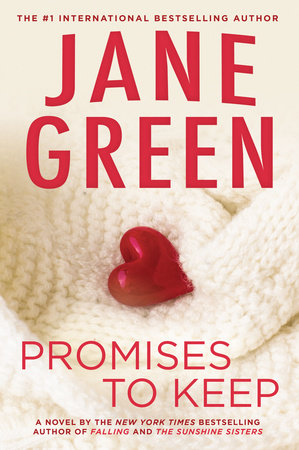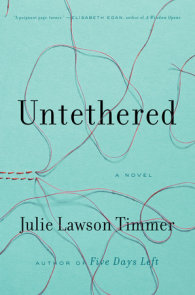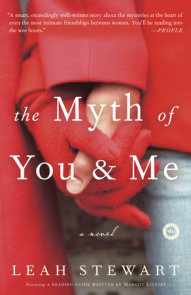READERS GUIDE
Questions and Topics for Discussion
INTRODUCTION
Promises to Keep is about the ties that bind and a circle of people united by love, who are there for one another despite sisterly differences, thirty–year–old grudges, and difficult ex–wives. Here, Jane Green has written a novel from the heart, filled with people she knows and lessons she is grateful to have learned.
Callie Perry seems to have figured it all out. She’s a wonderful mother of two, wife of a great guy, friend to many, and big sister settled in Bedford, New York, making a good living as a family photographer. Her free–spirited younger sister, Steffi, finally seems to be settling down a bit herself—at least when she discovers that house sitting a big dog in a country house really can compete with a life of ne’er–do–well rocker boyfriends and cramped Manhattan apartments.
Callie’s best friend, Lila, is also riding a wave of good fortune. She’s finally met the man of her dreams, Ed, a lovable Brit with a wonderful son from a previous marriage. The only problems: Ed comes with a horrific ex–wife and the desire to have more kids, and Lila had long ago decided that kids weren’t in her future. But maybe, for such a special guy…
Honor and Walter are Callie’s divorced parents who haven’t spoken in thirty years. So Callie and Steffi couldn’t be more shocked when they learn the truth of what’s really going on between them.
At Callie’s birthday celebration, her friends gather around her, and her husband, Reece, gives a toast to Callie’s four cancer–free years. But when Callie’s headaches start up again with fierce intensity, it’s hard not to notice that her usual radiance is gone. She is readmitted to the hospital, and the outlook isn’t good. The cancer she fought so hard to beat years before has returned in a rare but deadly form called leptomeningeal carcinomatosis. Everyone receives the news nobody wants to hear: If she’s lucky, Callie has one year left to enjoy the wonderful life she created, the life she so deserves.
Based in part on Jane Green’s experience with losing her dear friend Heidi to cancer, Promises to Keep is her most personal and powerful novel yet. It is about loving and letting go, but it’s also about finding one’s authentic self, having courage, and living fully a life filled with love.
ABOUT JANE GREEN
Jane Green Warburg has written eleven previous novels as Jane Green, several of which were New York Times bestsellers. A native Londoner, she lives, writes, and cooks in Connecticut with her husband, Ian Warburg, and their blended family of six children.
A CONVERSATION WITH JANE GREEN
Q. “Heidi’s Story” reveals that this novel emerged from your personal experience of losing one of your best friends to cancer. How did that affect your writing process? Do you consider this novel more autobiographical than other books you’ve written?
This isn’t Heidi’s story, although I hope I have captured something of her spirit, nor is it autobiographical. What it is, however, is the most personal book I have ever written, because I wanted it to be a worthy tribute, and I wrote most of it when I was in the depths of grief. I put a little of me in all my characters, and certainly draw upon the themes of my life for inspiration, but the characters are all very much their own people.
Q. Promises to Keep centers on a profoundly emotional journey for Callie and her loved ones. What kind of emotional journey did you go through while writing the book?
I wrote some of the book while Heidi was ill, and we’d talk about it. I’d tell her about the characters, and it felt easy and fun. Then, as Heidi became sicker, I didn’t have the emotional reserves to keep writing, and I didn’t start again until after she died. I wrote the book, as I write all of them, at the local library, and found myself regularly stopping to bury my head in my hands and sob. It was draining, and cathartic. I needed to write about it to process my feelings, but it didn’t make the loss any easier.
Q. The characters in this novel represent a wide range of parenting styles, shaped in part by gender, generation, and socioeconomic status. What observations or reflections do you have about current parenting trends?
I heard someone say recently that they grew up in a time when adults were the boss, and they are now living in a time when children are the boss, so when is it going to be their turn? It made me laugh and has a familiar ring of truth. Parenting, and particularly other people’s parenting, tends to bring out the worst in us—never have I experienced more judgment than at the hands of other mothers, particularly of babies. Thankfully I am now older, and wiser, as are my children, and I think we are all doing the best we can. I like to think that I am raising my children to be adults, to exist as good people in the world, to recognize boundaries, to have good manners, and to respect others.
Q. Why did you decide to include recipes at the end of every chapter?
I am a huge foodie and a cook. I gather easy recipes from all over, create my own, and spend my life showing the people I love that I love them by cooking for them. When I started to write about Steffi and found myself including lavish descriptions of the food, it suddenly seemed obvious to include the recipes.
Q. As Lila prepares for Clay’s recital, she thinks: “What on earth is she going to wear? Who, more importantly, does she want to be tonight?” [p. 144]. In this and other sections, the book takes up the question of how appearance and image relate to identity. Why is this theme especially important in a book about contemporary women?
Insecurity seems to be the curse of modern times, and too often we use the external as a form of armor, hoping the right stuff will make us feel good enough, will have others recognize us as being good enough. I don’t think this applies to all modern women, but living in an affluent community brings with it a level of competition and brings out our worst insecurities.
Q. While you were writing, did you ever consider rewriting Heidi’s history by having Callie survive her second fight with cancer? What made you decide that her death was a necessary part of the story?
I had to deal with my own grief, and this was the only way I knew how. And from the beginning, whatever had happened to Heidi, I knew that Callie wasn’t going to make it. I wanted to look at grief, at how it changes things, how it brings people together.
Q. What words or images would you offer to someone whose loved one has been diagnosed with cancer?
I have to say that what happens to Callie occurs in less than 1 percent of cancer sufferers. It is extremely rare, and women reading this book should not be worrying that this will happen to them or those they love. Second, I would say that what I learned throughout my journey with my friend was that love is a verb. Anyone can say the words “I love you,” but loving someone requires Acts. Of. Love. It is about putting that person first, making time for her, thinking of what you can do for her to make her happy before she has even had a chance to think about what that might be. And do it now. Not tomorrow. Or next week. Today is really all we have.
DISCUSSION QUESTIONS






















